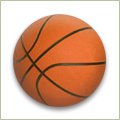
Wednesday, July 9, 2008
A "Tri" for an Eye

Thursday, June 14, 2007
The Eyes Have It -Part II
In my last entry (The Eyes Have It), I stressed the important contribution that vision plays in the game of basketball.
But did you know that basketball carries one of the highest risks for sports-related eye injury?
Here are the facts:
* The US Consumer Product Safety Commission has reported that, each year in the United States, more than a quarter of a million children under the age of 15 sustain a sports-related eye injury.
* Basketball and baseball are the two sports associated with the most eye injuries in athletes between the ages of 5-24 years old.
* Basketball accounts for almost 1/3 (29%) of all sports-related eye injuries.
* One in ten college basketball players will sustain an eye injury each season.
* More than half of basketball related eye injuries are cuts or scrapes to the eyelid while another 1/3 are bruises to the area around the eyes. Eleven percent are scrapes to the cornea, the clear tissue that covers your eyeball.
* About 7% of sports-related eye injuries require a trip to the emergency room and some even result in permanent loss of sight.
These statistics are not meant to stop you from playing basketball.
But they should get your attention.
So what can you do to reduce your risk of getting poked in the eye when everyone’s reaching/battling for the ball?
According to the Joint Policy Statement from the American Academy of Pediatrics and the American Academy of Opthalmology:
* All athletes and their parents should be made aware of the risks associated with participation in sports. (Just did that!)
* Any athlete with worse than 20/40 corrected vision in one eye MUST wear eye protectors when playing. (Think about it, if you injure your “good” eye, you might never be able to drive a car, let alone drive down the lane).
* Safety sports eyewear should meet the requirements of the American Society for Testing and Materials (ASTM) Standard F803 (just look at the label) for basketball players.
* Safety eyewear should be replaced when it no longer fits correctly, is damaged, or is yellowed with age (because it might no longer be strong enough to protect you).
A few other thoughts:
While contact lenses can improve your vision, they don’t provide any extra protection for your eyes. Appropriate eye protectors should still be worn over them.
Regular “streetwear” glasses that do not have non-breakable polycarbonate lenses can actually increase your risk of a severe eye injury since they are more likely to shatter.
When worn correctly, protective eyewear can reduce the risk of serious injury to your eyes by 90%.
So do your best James Worthy and Kareem Abdul-Jabbar impression and drive the lane with no fear, knowing that you’ve got your eyes covered.
For more information and resources about eye protection and youth sports, go to:
The Coalition to Prevent Sports Eye Injuries
http://www.sportseyeinjuries.com/
Protective Eyewear for Young Athletes
http://aappolicy.aappublications.org/cgi/reprint/pediatrics;113/3/619.pdf
Promoting the Use of Protective Eyewear for Children in Sports
http://www.aoa.org/x7382.xml
Tuesday, June 12, 2007
The Eyes Have It
“She’s got great court vision”
You often hear talented basketball players described this way.
But how important is it to have good vision when you’re playing hoops?
Well, you can play basketball well without being able to smell, taste, or hear.
You can even play basketball well without being able to walk or run,
but just try to play basketball with your eyes closed.
Nope.
Not happening.
Vision plays an important part in balance (Try standing on one leg with your eyes open and then with your eye closed), coordination and speed (DON’T try running a suicide sprint on the court with your eyes closed) and hand-eye coordination (Throw a ball up and catch it with your eyes open, and then with your eyes closed).
Because of the constantly changing position of the ball and players, a basketball athlete needs to have excellent vision to reach his/her potential.
Different positions place different demands on your sight during a game. While guards usually play facing the hoop, a post player who plays with his/her back to the basket and turns to shoot has only a few milliseconds to find and lock in on the rim or backboard. Players who hang out around the 3-point line need better depth perception than those who are shooting mostly lay-ups.
So what can you do? A good first step is to get a sports vision specialist (usually an optometrist or ophthalmologist) to perform a sports vision assessment. This not only includes the basic eye chart testing for visual acuity, but might also include measures of dynamic (in motion) visual acuity, peripheral vision, depth perception, tracking, and visual memory. While you’re at it, a basic test of color vision wouldn’t hurt.
Once you have more information about your visual strengths and areas that need improving, there are exercises you can perform to improve your passing, catching, and shooting.
In my next entry, I’ll talk about steps you can take to protect your eyes from injury while you’re playing







